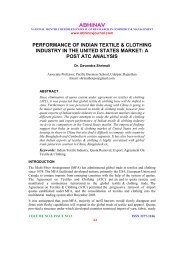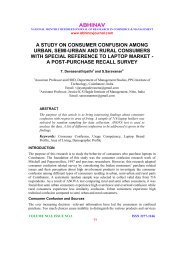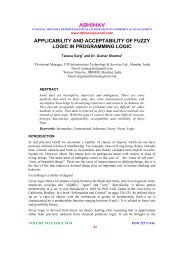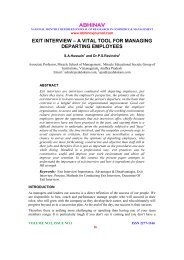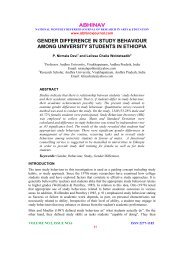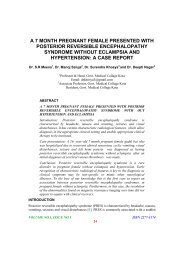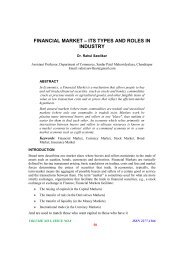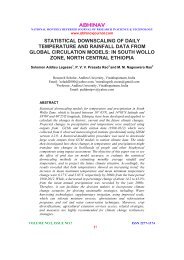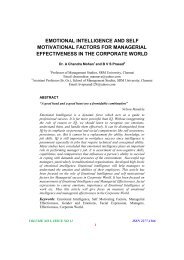A comparative study of cross-selling practices in - Abhinav Institute ...
A comparative study of cross-selling practices in - Abhinav Institute ...
A comparative study of cross-selling practices in - Abhinav Institute ...
Create successful ePaper yourself
Turn your PDF publications into a flip-book with our unique Google optimized e-Paper software.
A COMPARATIVE STUDY OF CROSS-SELLING<br />
PRACTICES IN PUBLIC SECTOR AND PRIVATE<br />
SECTOR BANKS IN MYSORE<br />
Jat<strong>in</strong> Pandey 1 and Sanjana Mutt 2<br />
Student, Sri Jayachamarajendra College <strong>of</strong> Eng<strong>in</strong>eer<strong>in</strong>g, Mysore<br />
Email: 1 pandey.jat<strong>in</strong>@gmail.com, 2 sanjanacm.cm@gmail.com<br />
ABSTRACT<br />
The <strong>study</strong> focuses on compar<strong>in</strong>g the <strong>cross</strong>-<strong>sell<strong>in</strong>g</strong> <strong>practices</strong> <strong>in</strong> public sector<br />
and private sector banks <strong>in</strong> Mysore. The <strong>study</strong> is been conducted to identify<br />
the exist<strong>in</strong>g <strong>cross</strong>-<strong>sell<strong>in</strong>g</strong> <strong>practices</strong> <strong>in</strong> public and private sector banks and to<br />
know the hurdles faced by banks <strong>in</strong> <strong>cross</strong>-<strong>sell<strong>in</strong>g</strong> and <strong>in</strong>itiatives taken by<br />
banks for improv<strong>in</strong>g effectiveness <strong>of</strong> <strong>cross</strong>-<strong>sell<strong>in</strong>g</strong>. The <strong>study</strong> was limited to<br />
bank employees <strong>in</strong>dulg<strong>in</strong>g <strong>in</strong> <strong>cross</strong>-<strong>sell<strong>in</strong>g</strong> <strong>practices</strong> a<strong>cross</strong> the banks <strong>in</strong><br />
Mysore. A total <strong>of</strong> 6 banks were considered; 3 from public sector and 3 from<br />
private sector banks. The number <strong>of</strong> employees who were questioned were<br />
totally 90. The banks were chosen after <strong>study</strong><strong>in</strong>g the background <strong>of</strong> the<br />
banks. The <strong>study</strong> provided various details like banks perceived benefits, the<br />
<strong>in</strong>itiatives taken, the hurdles faced and the effectiveness.<br />
Keywords: Cross-<strong>sell<strong>in</strong>g</strong> <strong>practices</strong>, effectiveness <strong>of</strong> <strong>cross</strong>-<strong>sell<strong>in</strong>g</strong>, public<br />
sector and private sector banks <strong>in</strong> Mysore<br />
INTRODUCTION<br />
Cross-<strong>sell<strong>in</strong>g</strong> is <strong>sell<strong>in</strong>g</strong> new products to exist<strong>in</strong>g customers has long been on most banks'<br />
agenda and has been constantly discussed <strong>in</strong> various <strong>in</strong>ternal/external meet<strong>in</strong>gs. Yet<br />
historically, few banks have had significant <strong>cross</strong>-<strong>sell<strong>in</strong>g</strong> success. When establish<strong>in</strong>g <strong>cross</strong><strong>sell<strong>in</strong>g</strong><br />
strategies, banks must remember that the ultimate goal is improv<strong>in</strong>g the bottom l<strong>in</strong>e.<br />
Sell<strong>in</strong>g <strong>of</strong> banks products/services to an already exist<strong>in</strong>g customer—is the broad def<strong>in</strong>ition <strong>of</strong><br />
what <strong>cross</strong> sell means. It can be <strong>sell<strong>in</strong>g</strong> an exist<strong>in</strong>g check<strong>in</strong>g account customer a credit card<br />
or <strong>sell<strong>in</strong>g</strong> an exist<strong>in</strong>g credit card customer a mortgage. Banks have been us<strong>in</strong>g <strong>cross</strong> <strong>sell<strong>in</strong>g</strong><br />
as a market<strong>in</strong>g approach to expand their footpr<strong>in</strong>t and also <strong>in</strong>crease their customer base.<br />
Every bank has its own logic <strong>of</strong> how many relationships it would like to have with its<br />
customers. The more relationships the bank has with a customer is tantamount to one hav<strong>in</strong>g<br />
a better wallet share <strong>of</strong> the customer. More spends on all the products <strong>of</strong> the bank leads to<br />
better top- and bottom-l<strong>in</strong>e performance. Conversely <strong>in</strong> pursuit <strong>of</strong> <strong>sell<strong>in</strong>g</strong> newer products to<br />
exist<strong>in</strong>g customers, banks tend to forget that pr<strong>of</strong>itability <strong>of</strong> a customer is very important<br />
aspect and just not addition <strong>of</strong> another product. If banks tend to attract customers with free<br />
check<strong>in</strong>g <strong>in</strong> the hope <strong>of</strong> gett<strong>in</strong>g other bus<strong>in</strong>ess from those customers and if this does not<br />
VOLUME NO.1, ISSUE NO.6 ISSN 2277-1166<br />
1
ABHINAV<br />
NATIONAL MONTHLY REFEREED JOURNAL OF REASEARCH IN COMMERCE & MANAGEMENT<br />
www.abh<strong>in</strong>avjournal.com<br />
happen then the purpose beh<strong>in</strong>d <strong>cross</strong>-<strong>sell<strong>in</strong>g</strong> is defeated. As well, some banks forget that the<br />
objective was pr<strong>of</strong>it—not a higher <strong>cross</strong>-sell. Many tactics merely <strong>in</strong>crease <strong>cross</strong>-sell—not<br />
pr<strong>of</strong>it. Offer<strong>in</strong>g discounts for additional products and services, but at the cost <strong>of</strong> forgone<br />
revenue, results <strong>in</strong> losses.<br />
Cross-<strong>sell<strong>in</strong>g</strong> comes with its advantages, <strong>of</strong> course. It considerably reduces customer<br />
acquisition costs, servic<strong>in</strong>g, and market<strong>in</strong>g and communication costs and thereby<br />
substantially <strong>in</strong>creases spread for banks. It is well understood and key f<strong>in</strong>d<strong>in</strong>g that greater the<br />
number <strong>of</strong> products held by customer leads to an <strong>in</strong>creased probability <strong>of</strong> retention.<br />
Successful <strong>cross</strong>-<strong>sell<strong>in</strong>g</strong> requires that banks understand what their customers need and that<br />
the bank keep track <strong>of</strong> their <strong>in</strong>teraction via phone bank<strong>in</strong>g, web, walk <strong>in</strong>, etc. Just mak<strong>in</strong>g<br />
phone calls to sell loans or plastic cards that the customer does not desire may <strong>of</strong>ten end up<br />
annoy<strong>in</strong>g him. These <strong>practices</strong> are different among private and public sector banks.<br />
Therefore it has been found that there exists difference <strong>in</strong> the <strong>cross</strong>-<strong>sell<strong>in</strong>g</strong> <strong>practices</strong> between<br />
public sector and private sector banks, which has lead to the <strong>study</strong>.<br />
Variables<br />
The construct <strong>of</strong> variables to consider <strong>in</strong> the <strong>study</strong> are perceived benefits, <strong>in</strong>itiatives,<br />
effectiveness and hurdles.<br />
‣ Perceived benefit: The benefits which have been perceived by the bank with regard<br />
to <strong>cross</strong>-<strong>sell<strong>in</strong>g</strong> (reta<strong>in</strong><strong>in</strong>g customers, Employee engagement, <strong>in</strong>crease customer<br />
base.).<br />
‣ Initiatives: The new measure/<strong>in</strong>troductory steps taken by the banks to improve the<br />
<strong>cross</strong>-<strong>sell<strong>in</strong>g</strong> <strong>practices</strong> and the efficiency/performance <strong>of</strong> the employees <strong>in</strong> <strong>cross</strong><strong>sell<strong>in</strong>g</strong>.(Tra<strong>in</strong><strong>in</strong>g<br />
to employees <strong>of</strong> the bank, advisory services to customers)<br />
‣ Effectiveness: This is best described as the <strong>cross</strong>-<strong>sell<strong>in</strong>g</strong> standard achieved hav<strong>in</strong>g<br />
knowledge and data base with regard to customers and be<strong>in</strong>g rewarded on the<br />
standard achieved. (Incentives, monitor<strong>in</strong>g, relationship among subsidiaries )<br />
‣ Hurdles: Obstacles faced by the banks <strong>in</strong> effective <strong>cross</strong>-<strong>sell<strong>in</strong>g</strong>.(Aggressive <strong>cross</strong><br />
<strong>sell<strong>in</strong>g</strong>, irate customers.)<br />
LITERATURE REVIEW<br />
Wagner A. Kamakuraa,*, Michel Wedelb,c, Fernando de Rosad, Jose Afonso Mazzone.<br />
Cross-<strong>sell<strong>in</strong>g</strong> perta<strong>in</strong>s to efforts to <strong>in</strong>crease the number <strong>of</strong> products or services that a<br />
customer uses with<strong>in</strong> a firm. Cross-<strong>sell<strong>in</strong>g</strong> products and services to current customers has<br />
lower associated cost than acquir<strong>in</strong>g new customers, because the firm already has some<br />
relationship with the customer. A proper implementation <strong>of</strong> <strong>cross</strong>-<strong>sell<strong>in</strong>g</strong> can only be<br />
achieved if there is an <strong>in</strong>formation <strong>in</strong>frastructure that allows managers to <strong>of</strong>fer customers<br />
products and services that tap <strong>in</strong>to their needs, but have not been sold to them yet.<br />
A mixed data factor analyser is proposed that comb<strong>in</strong>es <strong>in</strong>formation from a survey with data<br />
from the customer database on service usage and transaction volume, to make probabilistic<br />
predictions <strong>of</strong> ownership <strong>of</strong> services with the service provider and with competitors.<br />
VOLUME NO.1, ISSUE NO.6 ISSN 2277-1166<br />
2
ABHINAV<br />
NATIONAL MONTHLY REFEREED JOURNAL OF REASEARCH IN COMMERCE & MANAGEMENT<br />
www.abh<strong>in</strong>avjournal.com<br />
This data-augmentation tool is more flexible <strong>in</strong> deal<strong>in</strong>g with the type <strong>of</strong> data that are usually<br />
present <strong>in</strong> transaction databases. We test the proposed model us<strong>in</strong>g survey and transaction<br />
data from a large commercial bank. We assume four different types <strong>of</strong> distributions for the<br />
data: Bernoulli for b<strong>in</strong>ary service usage items, rank-order b<strong>in</strong>omial for satisfaction rank<strong>in</strong>gs,<br />
Poisson for service usage frequency, and normal for transaction volumes. We estimate the<br />
model us<strong>in</strong>g simulated likelihood (SML). The graphical representation <strong>of</strong> the weights<br />
produced by the model provides managers with the opportunity to quickly identify <strong>cross</strong><strong>sell<strong>in</strong>g</strong><br />
opportunities.<br />
We exemplify this and show the predictive validity <strong>of</strong> the model on a hold-out sample <strong>of</strong><br />
customers, where survey data on service usage with competitors is lack<strong>in</strong>g. We use G<strong>in</strong>i<br />
concentration coefficients to summarize power curves <strong>of</strong> prediction, which reveals that our<br />
model outperforms a compet<strong>in</strong>g latent trait model on the majority <strong>of</strong> service predictions.<br />
CRM tools for forg<strong>in</strong>g stronger relationships with customers is <strong>cross</strong>-<strong>sell<strong>in</strong>g</strong>. As a customer<br />
acquires additional services or products from a vendor, the number <strong>of</strong> po<strong>in</strong>ts where customer<br />
and vendor connect <strong>in</strong>creases, lead<strong>in</strong>g to a higher switch<strong>in</strong>g cost to the customer.<br />
Another important benefit <strong>of</strong> <strong>cross</strong>-<strong>sell<strong>in</strong>g</strong>, not as immediately visible as the <strong>in</strong>crease <strong>in</strong><br />
customer switch<strong>in</strong>g costs, is that it allows the firm to learn more about the customer’s<br />
preferences and buy<strong>in</strong>g behaviour, thereby <strong>in</strong>creas<strong>in</strong>g its ability to satisfy the customer’s<br />
needs more effectively than competitors.<br />
Shibo Li, Baohong Sun and Ronald T.Wilcox1 This commonly observed situation <strong>of</strong>fers<br />
significant opportunities for companies carry<strong>in</strong>g multiple products and services to “<strong>cross</strong>sell”<br />
other products and services to their exist<strong>in</strong>g customer base. In addition, their purpose is<br />
to predict what type <strong>of</strong> consumer is more beneficial to target <strong>in</strong> the future rather than when<br />
an <strong>in</strong>dividual should be targeted. This was the ma<strong>in</strong> objective <strong>of</strong> this <strong>study</strong>. The sample size<br />
considered <strong>in</strong> this <strong>study</strong> is 20f<strong>in</strong>ancial products, 1201 randomly selected households. The<br />
methodology adopted was descriptive <strong>in</strong> nature. This research developed a model useful for<br />
predict<strong>in</strong>g product and service acquisition <strong>in</strong> markets where consumers have sequentially<br />
ordered demands .Our model was designed to leverage these reoccurr<strong>in</strong>g purchase patterns<br />
and <strong>in</strong> so do<strong>in</strong>g <strong>in</strong>crease the predictive accuracy <strong>of</strong> our attempts to model product and service<br />
choice. We demonstrated our approach on data collected from a large Midwestern bank and<br />
found that <strong>in</strong>clud<strong>in</strong>g these proposed effects significantly improved predictive performance.<br />
We expect that there are many other service environments <strong>in</strong> which <strong>in</strong>clud<strong>in</strong>g <strong>in</strong>formation on<br />
natural order<strong>in</strong>g would yield valuable <strong>in</strong>sights.<br />
Wittmann, Georg, ibi research at the University <strong>of</strong> Regensburg, Universitätsstrasse 31,<br />
93040 Regensburg, Germany. The ma<strong>in</strong> objective <strong>of</strong> the <strong>study</strong> was to f<strong>in</strong>d the factors<br />
<strong>in</strong>fluence the <strong>cross</strong>-<strong>sell<strong>in</strong>g</strong> potential <strong>of</strong> SME customers and how can it be measured? The<br />
keywords used <strong>in</strong> the <strong>study</strong> are E-Bank<strong>in</strong>g, Cross-Sell<strong>in</strong>g, Data M<strong>in</strong><strong>in</strong>g, Multi-Channel-<br />
Management, Customer-Relationship-Management (CRM), Small and Medium Enterprises<br />
(SME). The sample size adopted was a yearly evaluation <strong>of</strong> about 400 retail bank<strong>in</strong>g<br />
websites us<strong>in</strong>g a detailed criteria catalogue. The random variables are considered ,<br />
demographic, past purchase, and psychographic <strong>in</strong>formation a probability <strong>of</strong> purchase is<br />
estimated for each customer.<br />
VOLUME NO.1, ISSUE NO.6 ISSN 2277-1166<br />
3
ABHINAV<br />
NATIONAL MONTHLY REFEREED JOURNAL OF REASEARCH IN COMMERCE & MANAGEMENT<br />
www.abh<strong>in</strong>avjournal.com<br />
Richa sharma vyas and najaguna rudrayya bhusnur math; year: :received 26th may<br />
2006 journal: journal <strong>of</strong> f<strong>in</strong>ancial services market<strong>in</strong>g(2006)10, 123-134.<br />
Doi.10.1057/palgrave.fsm.4760027 This paper is a <strong>study</strong> <strong>of</strong> <strong>cross</strong>-<strong>sell<strong>in</strong>g</strong> <strong>practices</strong> <strong>in</strong> Indian<br />
public and private sector banks through the case <strong>study</strong> method. The <strong>study</strong> revealed that<br />
<strong>cross</strong>-<strong>sell<strong>in</strong>g</strong> <strong>practices</strong> <strong>in</strong> public sector and private sector banks are quite different. These<br />
differences emerge ma<strong>in</strong>ly from their different philosophy, background, and dist<strong>in</strong>ct target<br />
customers segments. However, both sectors can learn from each other; public sector banks<br />
can <strong>in</strong>troduce specialised tra<strong>in</strong><strong>in</strong>g and <strong>in</strong>centives, where as private sector banks need to<br />
<strong>in</strong>troduce appropriate control mechanism and avoid <strong>in</strong>discrim<strong>in</strong>ate <strong>cross</strong>-<strong>sell<strong>in</strong>g</strong>. The paper<br />
also br<strong>in</strong>gs out the elements <strong>of</strong> successful <strong>cross</strong>-<strong>sell<strong>in</strong>g</strong> <strong>in</strong> India.<br />
This paper aims to understand <strong>cross</strong> <strong>sell<strong>in</strong>g</strong> techniques adopted by banks <strong>in</strong> India through a<br />
<strong>study</strong> <strong>of</strong> public sector and new private sector banks, the objective is to explore and<br />
understand the follow<strong>in</strong>g:<br />
i) Exist<strong>in</strong>g <strong>cross</strong> <strong>sell<strong>in</strong>g</strong> <strong>practices</strong> <strong>in</strong> different banks<br />
ii) Hurdles faced by banks <strong>in</strong> <strong>cross</strong> <strong>sell<strong>in</strong>g</strong><br />
iii) Initiatives taken by banks for improv<strong>in</strong>g effectiveness <strong>of</strong> <strong>cross</strong> <strong>sell<strong>in</strong>g</strong>.<br />
iv) Elements <strong>of</strong> effective <strong>cross</strong> <strong>sell<strong>in</strong>g</strong> <strong>in</strong> India.<br />
The keywords are <strong>cross</strong> <strong>sell<strong>in</strong>g</strong>, customer retention, bank<strong>in</strong>g, customer relationship. The<br />
sample size determ<strong>in</strong>ed was 6banks; 3 from public sector and 3 from private sector, 36<br />
<strong>of</strong>ficials, 6 from each bank were <strong>in</strong>terviewed. The type <strong>of</strong> <strong>study</strong> was exploratory nature <strong>of</strong><br />
<strong>study</strong>. Qualitative <strong>in</strong>terviews were conducted.<br />
Year: Received (<strong>in</strong> revised form): 16th November, 2003; Konstant<strong>in</strong>os Lymberopoulos,<br />
Ioannis E. Chaniotakis, Magdal<strong>in</strong>i Soureli. This paper tries to identify the opportunities<br />
for banks to <strong>cross</strong>-sell <strong>in</strong>surance products via their branch network. — exam<strong>in</strong>e whether or<br />
not retail bank customers are aware <strong>of</strong> <strong>in</strong>surance <strong>sell<strong>in</strong>g</strong> through bank branch networks, and<br />
are will<strong>in</strong>g to purchase <strong>in</strong>surance products from their banks<br />
— identify the reasons that customers would buy <strong>in</strong>surance from banks and the particular<br />
<strong>in</strong>surance products that could be <strong>cross</strong>-sold by banks<br />
— <strong>in</strong>vestigate the factors that express customers’ attitudes to banks and <strong>in</strong>surance companies<br />
<strong>in</strong> relation to the provision <strong>of</strong> <strong>in</strong>surance products. Opportunities for banks to <strong>cross</strong>-sell<br />
<strong>in</strong>surance products <strong>in</strong> Greece. test potential relationships between these factors and<br />
customers’ demographic characteristics, awareness and the level <strong>of</strong> use <strong>of</strong> <strong>in</strong>surance<br />
products.<br />
— identify specific customer segments which are more likely to purchase <strong>in</strong>surance<br />
programmes from banks.<br />
The sample size considered was the target population comprised men and women, over 21<br />
years old, who had deal<strong>in</strong>gs with a bank or an <strong>in</strong>surance company. The methods adopted was<br />
descriptive research, non-probability sampl<strong>in</strong>g was used; questionnaire. Spss s<strong>of</strong>tware.<br />
VOLUME NO.1, ISSUE NO.6 ISSN 2277-1166<br />
4
ABHINAV<br />
NATIONAL MONTHLY REFEREED JOURNAL OF REASEARCH IN COMMERCE & MANAGEMENT<br />
www.abh<strong>in</strong>avjournal.com<br />
METHODOLOGY<br />
This is an empirical <strong>study</strong>. The follow<strong>in</strong>g presents scope <strong>of</strong> the <strong>study</strong>, objectives, <strong>study</strong><br />
design and limitations.<br />
SCOPE OF THE STUDY<br />
The <strong>study</strong> was limited to bank employees <strong>in</strong>dulg<strong>in</strong>g <strong>in</strong> <strong>cross</strong>-<strong>sell<strong>in</strong>g</strong> <strong>practices</strong> a<strong>cross</strong> the<br />
banks <strong>in</strong> Mysore. A total <strong>of</strong> 6 banks were considered; 3 from public sector and 3 from<br />
private sector banks. The number <strong>of</strong> employees who were questioned were totally 90. The<br />
banks were chosen after <strong>study</strong><strong>in</strong>g the background <strong>of</strong> the banks. The <strong>study</strong> provided various<br />
details like banks perceived benefits, the <strong>in</strong>itiatives taken, the hurdles faced and the<br />
effectiveness.<br />
OBJECTIVES OF THE STUDY<br />
1. To identify the exist<strong>in</strong>g <strong>cross</strong>-<strong>sell<strong>in</strong>g</strong> <strong>practices</strong> <strong>in</strong> public and private sector banks.<br />
2. To know the hurdles faced by banks <strong>in</strong> <strong>cross</strong>-<strong>sell<strong>in</strong>g</strong> and <strong>in</strong>itiatives taken by banks<br />
for improv<strong>in</strong>g effectiveness <strong>of</strong> <strong>cross</strong>-<strong>sell<strong>in</strong>g</strong>.<br />
LIMITATION OF THE STUDY<br />
The <strong>study</strong> was conducted with<strong>in</strong> the geographical boundary <strong>of</strong> Mysore city.<br />
The result would have been better if the sample size was <strong>in</strong>creased.<br />
The respondent denied to write their banks name <strong>in</strong> the questionnaire which was<br />
used to collect the primary data<br />
DATA COLLECTION METHOD<br />
Accord<strong>in</strong>g to the previous studies the methodology used was <strong>in</strong>terview method, because<br />
<strong>cross</strong>-<strong>sell<strong>in</strong>g</strong> was newly <strong>in</strong>troduced and was not prom<strong>in</strong>ently used practice, so <strong>in</strong>terview<br />
would help the researcher to explore about the <strong>cross</strong>-<strong>sell<strong>in</strong>g</strong> <strong>practices</strong>.<br />
But <strong>in</strong> this <strong>study</strong> questionnaire method is been adopted for the <strong>study</strong> as the <strong>cross</strong>-<strong>sell<strong>in</strong>g</strong> is<br />
been carried <strong>in</strong> all the banks and the bank employees are aware <strong>of</strong> it, therefore questionnaire<br />
would be sufficient to gather <strong>in</strong>formation required for this <strong>study</strong>.<br />
The <strong>study</strong> is made by tak<strong>in</strong>g 90 respondents, i.e. 15 from each bank out <strong>of</strong> 6 banks, 3-public<br />
sector banks and 3-private sector banks. The required primary data is collected through<br />
survey method. The survey <strong>in</strong>strument used <strong>in</strong> the <strong>study</strong> is questionnaire. The questions were<br />
built on 5 po<strong>in</strong>t likert scale.<br />
Sample size<br />
The <strong>study</strong> has covered a total <strong>of</strong> 90 employees from Private and Public sector banks. The<br />
follow<strong>in</strong>g equation was considered to f<strong>in</strong>d the sample size.<br />
N = Z 2 *(σ 2 )/ E 2<br />
Where,<br />
N = Sample size to be determ<strong>in</strong>ed<br />
VOLUME NO.1, ISSUE NO.6 ISSN 2277-1166<br />
5
ABHINAV<br />
NATIONAL MONTHLY REFEREED JOURNAL OF REASEARCH IN COMMERCE & MANAGEMENT<br />
www.abh<strong>in</strong>avjournal.com<br />
σ = maximum standard deviation <strong>of</strong> the data collected<br />
Z = The confidence coefficient ( 2 )<br />
E = Error (0.3)<br />
Accord<strong>in</strong>gly,<br />
= 2 2 * 1.40 2 /0.3 2<br />
87.11 respondents.<br />
However, to make the computations easy the sample size is <strong>in</strong>creased to 90. The respondents<br />
are selected from Mysore city banks. A total <strong>of</strong> 49 employees from Private sector banks and<br />
41 employees from Public sector banks were selected. The banks which were chosen for the<br />
<strong>study</strong> were; public sector- canara bank, vijaya bank, Punjab national bank. Private sector-<br />
IDBI bank, ICICI bank, HDFC bank.<br />
Sampl<strong>in</strong>g method<br />
The <strong>study</strong> uses convenience sampl<strong>in</strong>g. Convenience sampl<strong>in</strong>g is a non-probability sampl<strong>in</strong>g<br />
technique where subjects are selected because <strong>of</strong> their convenient accessibility and proximity<br />
to the researcher.<br />
Data analysis method<br />
The data was subjected to factor analytic procedure to uncover underly<strong>in</strong>g dimensions and<br />
also for establish<strong>in</strong>g content and discrim<strong>in</strong>ate validity. Cronbachs’ alpha was calculated to<br />
test the reliability <strong>of</strong> the measurements before subject<strong>in</strong>g the factor scores obta<strong>in</strong>ed from the<br />
factor analysis through <strong>in</strong>dependent t-test <strong>in</strong> order to test significant difference between<br />
public sector and private sector banks <strong>in</strong> Mysore. Given the methodology the follow<strong>in</strong>g<br />
chapter discusses the analysis and <strong>in</strong>terpretation thereon.<br />
RESULTS AND FINDINGS<br />
Prelim<strong>in</strong>ary Analysis<br />
Descriptive Analysis<br />
The details <strong>of</strong> mean, standard deviation, skewness and kurtosis for each measurement item<br />
are shown <strong>in</strong> the table below. Observation <strong>of</strong> the kurtosis and skewness reveals that all the<br />
variable items <strong>in</strong> kurtosis and skewness are less than 10 and 3 po<strong>in</strong>ts respectively, and thus<br />
the data confirms normality assumptions.<br />
VOLUME NO.1, ISSUE NO.6 ISSN 2277-1166<br />
6
ABHINAV<br />
NATIONAL MONTHLY REFEREED JOURNAL OF REASEARCH IN COMMERCE & MANAGEMENT<br />
www.abh<strong>in</strong>avjournal.com<br />
Table 1. Descriptive Statistics for PERCEIVED BENEFIT<br />
Slno. Measures Abbrevn Mean Skewness Kurtosis<br />
1. Cross-<strong>sell<strong>in</strong>g</strong> <strong>in</strong>creases<br />
PB1 1.7222 .020 -.465<br />
probability <strong>of</strong> reta<strong>in</strong><strong>in</strong>g customers<br />
2. Cross-<strong>sell<strong>in</strong>g</strong> decreases customer PB2 2.1778 .690 -.694<br />
acquisition cost<br />
3. Cross <strong>sell<strong>in</strong>g</strong> is one <strong>of</strong> the PB3 1.6222 .552 -.625<br />
strategy for employee<br />
engagement<br />
4. Cross <strong>sell<strong>in</strong>g</strong> is help<strong>in</strong>g gather<strong>in</strong>g PB4 2.2000 1.055 .263<br />
bank to <strong>in</strong>crease its customer<br />
base<br />
5. Cross <strong>sell<strong>in</strong>g</strong> helps <strong>in</strong> protect<strong>in</strong>g PB5 1.9667 8.416 76.521<br />
the relationship with the clients<br />
6. Cross-<strong>sell<strong>in</strong>g</strong> provides me an<br />
opportunity to ga<strong>in</strong> additional<br />
<strong>in</strong>come and advantages<br />
PB6 2.1222 .605 -.919<br />
Table 2. INITIATIVES<br />
Sl Measures Abbrevn Mean Skewness Kurtosis<br />
no.<br />
1. The tra<strong>in</strong><strong>in</strong>g was given to me before I <strong>in</strong>1 3.1889 -.280 -.925<br />
was assigned for the job <strong>of</strong> <strong>cross</strong><br />
<strong>sell<strong>in</strong>g</strong><br />
2. The tra<strong>in</strong><strong>in</strong>g given is help<strong>in</strong>g me to <strong>in</strong>2 2.7333 .005 -1.454<br />
<strong>cross</strong> sell the product effectively<br />
3. Tra<strong>in</strong><strong>in</strong>g for <strong>cross</strong> <strong>sell<strong>in</strong>g</strong> is available <strong>in</strong>3 3.5111 -.454 -.855<br />
at all levels <strong>of</strong> hierarchy<br />
4. Incorporation <strong>of</strong> market<strong>in</strong>g<br />
<strong>in</strong>4 2.7556 .013 -1.126<br />
philosophy and tra<strong>in</strong><strong>in</strong>g sessions for<br />
managers are be<strong>in</strong>g arranged at<br />
middle and senior level.<br />
5. Bank <strong>in</strong>itiates <strong>in</strong> provid<strong>in</strong>g f<strong>in</strong>ancial <strong>in</strong>5 2.5000 .427 -.873<br />
advisory services to customers<br />
6. Cross <strong>sell<strong>in</strong>g</strong> is done via phone <strong>in</strong>6 2.0444 .889 .510<br />
bank<strong>in</strong>g<br />
7. Cross <strong>sell<strong>in</strong>g</strong> is done via web IN7 2.2778 1.804 3.284<br />
8. Cross <strong>sell<strong>in</strong>g</strong> is done via walk <strong>in</strong>s IN8 1.9889 -.013 .704<br />
9. The bank uses CRM packages to IN9 1.9333 -.159 1.178<br />
develop <strong>cross</strong> <strong>sell<strong>in</strong>g</strong> strategies<br />
10. Based on exist<strong>in</strong>g accounts the IN10 2.1889 .536 .214<br />
customer needs are understood<br />
11. Easy access to CRM and data m<strong>in</strong><strong>in</strong>g<br />
tools<br />
IN11 2.4778 .502 -.568<br />
VOLUME NO.1, ISSUE NO.6 ISSN 2277-1166<br />
7
ABHINAV<br />
NATIONAL MONTHLY REFEREED JOURNAL OF REASEARCH IN COMMERCE & MANAGEMENT<br />
www.abh<strong>in</strong>avjournal.com<br />
Table 2. INITIATIVES (Contd…)<br />
Sl no. Measures Abbrevn Mean Skewness Kurtosis<br />
12. Bank has the latest technology and IN12 2.0000 .791 .336<br />
<strong>in</strong>tegrated all customer data<br />
13. Creation <strong>of</strong> a general manager IN13 2.2111 1.105 .854<br />
position ensures progress <strong>of</strong> <strong>cross</strong><br />
<strong>sell<strong>in</strong>g</strong><br />
14. Bank provides multiple contact po<strong>in</strong>ts IN14 1.6111 1.337 3.307<br />
15. Bank has taken steps to improve<br />
synergies with<strong>in</strong> the group<br />
IN15 2.1333 .622 -.839<br />
Sl<br />
no.<br />
1.<br />
2.<br />
3.<br />
4.<br />
5.<br />
6.<br />
7.<br />
8.<br />
Table 3. EFFECTIVENESS<br />
Measures Abbrevn Mean Skewness Kurtosis<br />
I am rewarded with <strong>in</strong>centives<br />
accord<strong>in</strong>g to my performance.<br />
Cross-<strong>sell<strong>in</strong>g</strong> is monitored by random<br />
check<strong>in</strong>g.<br />
I get motivated by the <strong>in</strong>centives earned<br />
by me<br />
All subsidiaries <strong>of</strong> the bank work <strong>in</strong><br />
close relationship.<br />
We use the services <strong>of</strong> external<br />
agencies to ga<strong>in</strong> contacts.<br />
I feel more comfortable while <strong>cross</strong><strong>sell<strong>in</strong>g</strong><br />
group company’s products.<br />
I have good knowledge about the<br />
product <strong>of</strong> all the subsidiary groups.<br />
Bank has a dedicated ‘customer account<br />
manager’ for each HNI customers.<br />
Table 4. HURDLES<br />
Ef1 2.6000 .808 -.547<br />
Ef2 2.8222 .273 -1.271<br />
Ef3 2.9556 .056 -1.375<br />
Ef4 2.7889 .172 -1.591<br />
Ef5 3.0222 -.345 -.685<br />
Ef6 2.7444 -.211 -1.435<br />
Ef7 2.8111 .008 -1.487<br />
Ef8 1.9889 1.183 1.181<br />
Slno. Measures Abbrevn Mean Skewness Kurtosis<br />
1.<br />
I get de-motivate due to lack <strong>of</strong> H1 1.8333 1.152 .967<br />
<strong>in</strong>centive<br />
2.<br />
The bank encourage aggressive H2 1.9222 -.020 .173<br />
<strong>cross</strong>-<strong>sell<strong>in</strong>g</strong>.<br />
I have encountered some <strong>in</strong>cidents H3 1.8333 .212 -.784<br />
3. <strong>of</strong> compla<strong>in</strong>ts from irate customer<br />
due to aggressive <strong>cross</strong>-<strong>sell<strong>in</strong>g</strong>.<br />
4.<br />
I have encountered role conflicts for H4 1.7000 .258 -.592<br />
<strong>cross</strong>-<strong>sell<strong>in</strong>g</strong> subsidiary’s product.<br />
5.<br />
I feel relatively uncomfortable while H5 2.0444 -.062 -.932<br />
<strong>cross</strong>-<strong>sell<strong>in</strong>g</strong> subsidiary’s products.<br />
VOLUME NO.1, ISSUE NO.6 ISSN 2277-1166<br />
8
ABHINAV<br />
NATIONAL MONTHLY REFEREED JOURNAL OF REASEARCH IN COMMERCE & MANAGEMENT<br />
www.abh<strong>in</strong>avjournal.com<br />
FACTOR ANALYSIS<br />
Table 5. KMO and Bartlett's Test<br />
Kaiser-Meyer-Olk<strong>in</strong> Measure <strong>of</strong> Sampl<strong>in</strong>g Adequacy. .589<br />
Bartlett's Test <strong>of</strong> Sphericity Approx. Chi-Square 1265.950<br />
Df 91<br />
Sig. .000<br />
Table 6. Total variance expla<strong>in</strong>ed<br />
Initial Eigen values<br />
Total<br />
% <strong>of</strong><br />
Variance<br />
Rotation Sums <strong>of</strong> Squared<br />
Load<strong>in</strong>gs<br />
Total % <strong>of</strong><br />
Variance<br />
Component<br />
Cumulative<br />
%<br />
Extraction Sums <strong>of</strong><br />
Squared Load<strong>in</strong>gs<br />
Total % <strong>of</strong> Cumulative<br />
Variance<br />
Cumulative<br />
%<br />
%<br />
1 5.558 39.700 39.700 5.558 39.700 39.700 5.007 35.763 35.763<br />
2 2.942 21.011 60.711 2.942 21.011 60.711 2.665 19.037 54.800<br />
3 1.945 13.893 74.604 1.945 13.893 74.604 2.029 14.491 69.291<br />
4 1.011 7.220 81.824 1.011 7.220 81.824 1.755 12.534 81.824<br />
Sl<br />
no<br />
Statements<br />
Table 7. Rotated Component Matrix for Brand Personality Scale<br />
1. The tra<strong>in</strong><strong>in</strong>g given is<br />
help<strong>in</strong>g me to <strong>cross</strong> sell<br />
the product effectively<br />
2. Tra<strong>in</strong><strong>in</strong>g for <strong>cross</strong> <strong>sell<strong>in</strong>g</strong><br />
is available at all levels <strong>of</strong><br />
hierarchy<br />
3. Incorporation <strong>of</strong> market<strong>in</strong>g<br />
philosophy and tra<strong>in</strong><strong>in</strong>g<br />
sessions for managers are<br />
be<strong>in</strong>g arranged at middle<br />
and senior level.<br />
4. Bank <strong>in</strong>itiates <strong>in</strong> provid<strong>in</strong>g<br />
f<strong>in</strong>ancial advisory services<br />
to customers<br />
5. I am rewarded with<br />
<strong>in</strong>centives accord<strong>in</strong>g to my<br />
performance.<br />
Abbrevn Component<br />
Tra<strong>in</strong><strong>in</strong>g<br />
&<br />
<strong>in</strong>centives<br />
<strong>in</strong>2 .863<br />
<strong>in</strong>3 .868<br />
<strong>in</strong>4 .887<br />
<strong>in</strong>5 .819<br />
Ef1 .777<br />
Technology<br />
& HNI<br />
CRM<br />
&<br />
cust.<br />
needs<br />
monitor<strong>in</strong><br />
g &<br />
aggressive<br />
<strong>cross</strong><br />
<strong>sell<strong>in</strong>g</strong><br />
VOLUME NO.1, ISSUE NO.6 ISSN 2277-1166<br />
9
Sl<br />
no<br />
ABHINAV<br />
NATIONAL MONTHLY REFEREED JOURNAL OF REASEARCH IN COMMERCE & MANAGEMENT<br />
www.abh<strong>in</strong>avjournal.com<br />
Table 7. Rotated Component Matrix for Brand Personality Scale (Contd…)<br />
Statements<br />
6. All subsidiaries <strong>of</strong> the<br />
bank work <strong>in</strong> close<br />
relationship<br />
7. We use the services <strong>of</strong><br />
external agencies to ga<strong>in</strong><br />
contacts.<br />
Abbrevn Component<br />
Tra<strong>in</strong><strong>in</strong>g<br />
&<br />
<strong>in</strong>centives<br />
Ef4 .657<br />
Ef5 .786<br />
Technology<br />
& HNI<br />
CRM<br />
&<br />
cust.<br />
needs<br />
monitor<strong>in</strong><br />
g &<br />
aggressive<br />
<strong>cross</strong><br />
<strong>sell<strong>in</strong>g</strong><br />
8. We use the services <strong>of</strong><br />
external agencies to ga<strong>in</strong><br />
contacts.<br />
9. Bank has the latest<br />
technology and <strong>in</strong>tegrated<br />
all customer data<br />
10 Bank has a dedicated<br />
‘customer account<br />
manager’ for each HNI<br />
customers<br />
11 The bank uses CRM<br />
packages to develop <strong>cross</strong><br />
<strong>sell<strong>in</strong>g</strong> strategies<br />
12 Based on exist<strong>in</strong>g accounts<br />
the customer needs are<br />
understood<br />
13 Cross-<strong>sell<strong>in</strong>g</strong> is monitored<br />
by random check<strong>in</strong>g.<br />
14 The bank encourage<br />
aggressive <strong>cross</strong>-<strong>sell<strong>in</strong>g</strong>.<br />
In6 .886<br />
In12 .813<br />
Ef8 .860<br />
<strong>in</strong>9 .787<br />
<strong>in</strong>10 .905<br />
Ef2 .649<br />
H2 .812<br />
VOLUME NO.1, ISSUE NO.6 ISSN 2277-1166<br />
10
ABHINAV<br />
NATIONAL MONTHLY REFEREED JOURNAL OF REASEARCH IN COMMERCE & MANAGEMENT<br />
www.abh<strong>in</strong>avjournal.com<br />
Table 8. Reliability for tra<strong>in</strong><strong>in</strong>g and <strong>in</strong>centives<br />
Sl no Questions Cronbach’s Alpha Number <strong>of</strong> Items<br />
1.<br />
The tra<strong>in</strong><strong>in</strong>g given is help<strong>in</strong>g me to <strong>cross</strong><br />
sell the product effectively.<br />
2.<br />
Tra<strong>in</strong><strong>in</strong>g for <strong>cross</strong> <strong>sell<strong>in</strong>g</strong> is available at<br />
all levels <strong>of</strong> hierarchy.<br />
3.<br />
Incorporation <strong>of</strong> market<strong>in</strong>g philosophy<br />
and tra<strong>in</strong><strong>in</strong>g sessions for managers are<br />
be<strong>in</strong>g arranged at middle and senior<br />
level.<br />
.918 7<br />
4.<br />
Bank <strong>in</strong>itiates <strong>in</strong> provid<strong>in</strong>g f<strong>in</strong>ancial<br />
advisory services to customers.<br />
5.<br />
I am rewarded with <strong>in</strong>centives accord<strong>in</strong>g<br />
to my performance.<br />
6.<br />
All subsidiaries <strong>of</strong> the bank work <strong>in</strong><br />
close relationship.<br />
7.<br />
We use the services <strong>of</strong> external agencies<br />
to ga<strong>in</strong> contacts.<br />
Table 9. Reliability for technology and HNI<br />
Sl no Questions Cronbach’s Alpha Number <strong>of</strong> Items<br />
1.<br />
We use the services <strong>of</strong> external<br />
agencies to ga<strong>in</strong> contacts.<br />
2.<br />
Bank has the latest technology and .854 3<br />
<strong>in</strong>tegrated all customer data<br />
Bank has a dedicated ‘customer<br />
3. account manager’ for each HNI<br />
customers<br />
Table 10. Reliability for CRM and Customer needs<br />
Sl no Questions Cronbach’s Alpha Number <strong>of</strong> Items<br />
1.<br />
The bank uses CRM packages to<br />
develop <strong>cross</strong> <strong>sell<strong>in</strong>g</strong> strategies .718 2<br />
2.<br />
Based on exist<strong>in</strong>g accounts the<br />
customer needs are understood<br />
Table 11. Reliability for CRM and Customer needs<br />
Sl no Questions Cronbach’s Alpha Number <strong>of</strong> Items<br />
1.<br />
Cross-<strong>sell<strong>in</strong>g</strong> is monitored by<br />
random check<strong>in</strong>g. .619 2<br />
2.<br />
The bank encourage aggressive<br />
<strong>cross</strong>-<strong>sell<strong>in</strong>g</strong>.<br />
VOLUME NO.1, ISSUE NO.6 ISSN 2277-1166<br />
11
ABHINAV<br />
NATIONAL MONTHLY REFEREED JOURNAL OF REASEARCH IN COMMERCE & MANAGEMENT<br />
www.abh<strong>in</strong>avjournal.com<br />
Independent sample t-test<br />
Table 12. Group Statistics<br />
occu N Mean Std. Deviation Std. Error Mean<br />
tra<strong>in</strong><strong>in</strong>g and <strong>in</strong>centives 1.00 49 18.6735 6.84467 .97781<br />
2.00 41 21.3902 5.73532 .89571<br />
technology and HNI 1.00 49 5.3265 1.02851 .14693<br />
2.00 41 6.8780 2.96812 .46354<br />
CRM and cust.needs 1.00 49 4.2245 1.26269 .18038<br />
2.00 41 4.0000 1.00000 .15617<br />
monitor<strong>in</strong>g and aggressive 1.00 49 4.3878 1.31998 .18857<br />
2.00 41 5.1707 1.82897 .28564<br />
Table 13. Independent Samples Test<br />
Levene's Test for Equality<br />
<strong>of</strong> Variances<br />
F Sig.<br />
tra<strong>in</strong><strong>in</strong>g and <strong>in</strong>centives Equal variances assumed .826 .366<br />
Equal variances not assumed<br />
technology and HNI Equal variances assumed 52.977 .000<br />
Equal variances not assumed<br />
CRM and cust.needs Equal variances assumed 1.626 .206<br />
Equal variances not assumed<br />
monitor<strong>in</strong>g and aggressive Equal variances assumed 9.729 .002<br />
Equal variances not assumed<br />
Table 14. Independent Samples Test<br />
t-test for Equality <strong>of</strong> Means<br />
t df Sig. (2-tailed)<br />
Tra<strong>in</strong><strong>in</strong>g and <strong>in</strong>centives Equal variances assumed -2.017 88 .047<br />
Equal variances not assumed -2.049 87.999 .043<br />
technology and HNI Equal variances assumed -3.425 88 .001<br />
Equal variances not assumed -3.191 48.037 .003<br />
CRM and cust.needs Equal variances assumed .922 88 .359<br />
Equal variances not assumed .941 87.759 .349<br />
monitor<strong>in</strong>g and aggresive Equal variances assumed -2.353 88 .021<br />
Equal variances not assumed -2.288 71.195 .025<br />
VOLUME NO.1, ISSUE NO.6 ISSN 2277-1166<br />
12
ABHINAV<br />
NATIONAL MONTHLY REFEREED JOURNAL OF REASEARCH IN COMMERCE & MANAGEMENT<br />
www.abh<strong>in</strong>avjournal.com<br />
tra<strong>in</strong><strong>in</strong>g and<br />
<strong>in</strong>centives<br />
technology and<br />
HNI<br />
CRM and cust.<br />
needs<br />
monitor<strong>in</strong>g and<br />
aggressive<br />
Table 15. Independent Samples Test<br />
t-test for Equality <strong>of</strong> Means<br />
Mean Difference Std. Error Difference<br />
Equal variances assumed 2.71677 1.34707<br />
Equal variances not assumed 2.71677 1.32605<br />
Equal variances assumed 1.55152 .45304<br />
Equal variances not assumed 1.55152 .48627<br />
Equal variances assumed .22449 .24356<br />
Equal variances not assumed .22449 .23860<br />
Equal variances assumed .78298 .33270<br />
Equal variances not assumed .78298 .34227<br />
Table 16. Independent Samples Test<br />
t-test for Equality <strong>of</strong> Means<br />
95% Confidence Interval <strong>of</strong> the<br />
Difference<br />
Lower<br />
Upper<br />
Tra<strong>in</strong><strong>in</strong>g and Equal variances assumed -5.39380 -.03975<br />
<strong>in</strong>centives<br />
Equal variances not assumed -5.35202 -.08153<br />
technology and HNI Equal variances assumed -2.45183 -.65121<br />
Equal variances not assumed -2.52921 -.57382<br />
CRM and cust.needs Equal variances assumed -.25954 .70852<br />
Equal variances not assumed -.24969 .69867<br />
monitor<strong>in</strong>g and<br />
aggressive<br />
Equal variances assumed -1.44415 -.12180<br />
Equal variances not assumed -1.46540 -.10055<br />
Independent sample’s t-test: Interpretation<br />
There is a significant differences between private and public sector bank <strong>in</strong> terms <strong>of</strong> tra<strong>in</strong><strong>in</strong>g<br />
and <strong>in</strong>centives (p=0.047 i.e p
ABHINAV<br />
NATIONAL MONTHLY REFEREED JOURNAL OF REASEARCH IN COMMERCE & MANAGEMENT<br />
www.abh<strong>in</strong>avjournal.com<br />
IMPLICATIONS<br />
‣ The <strong>study</strong> proves that there is a difference between private and public sector banks<br />
regard<strong>in</strong>g <strong>cross</strong>-<strong>sell<strong>in</strong>g</strong> <strong>practices</strong> among these two sectors.<br />
‣ The <strong>study</strong> determ<strong>in</strong>es that there has been differences found <strong>in</strong> terms <strong>of</strong> tra<strong>in</strong><strong>in</strong>g,<br />
<strong>in</strong>centives, monitor<strong>in</strong>g, CRM, technology, aggressive <strong>cross</strong>-<strong>sell<strong>in</strong>g</strong> <strong>practices</strong><br />
encouraged. Therefore Public sector banks should emphasize more on the tra<strong>in</strong><strong>in</strong>g<br />
programmes and <strong>in</strong>centive aspects as the private sector bank employees are more<br />
satisfied when compared to the public sector bank employees.<br />
‣ Accord<strong>in</strong>g to the f<strong>in</strong>d<strong>in</strong>gs the public sector banks emphasize more on technological<br />
up gradation, while <strong>in</strong> case <strong>of</strong> monitor<strong>in</strong>g it performs better therefore private sector<br />
banks has to improvise on this factor.<br />
‣ Aggressive <strong>cross</strong>-<strong>sell<strong>in</strong>g</strong> has been encouraged majorly by public sector banks <strong>in</strong><br />
order to <strong>in</strong>crease sales which is not the right way and which mal also lead to failure<br />
<strong>in</strong> reta<strong>in</strong><strong>in</strong>g customers and produces larger number for irate customers which has to<br />
be reduced.<br />
CONCLUSION<br />
Accord<strong>in</strong>g to the f<strong>in</strong>d<strong>in</strong>gs the public sector banks emphasize more on technological up<br />
gradation, while <strong>in</strong> case <strong>of</strong> monitor<strong>in</strong>g it performs better therefore private sector banks has to<br />
improvise on this factor. Aggressive <strong>cross</strong>-<strong>sell<strong>in</strong>g</strong> has been encouraged majorly by public<br />
sector banks <strong>in</strong> order to <strong>in</strong>crease sales which is not the right way and which may also lead to<br />
failure <strong>in</strong> reta<strong>in</strong><strong>in</strong>g customers and produces larger number for irate customers which has to<br />
be reduced. Therefore the <strong>study</strong> identifies that there is difference <strong>in</strong> the <strong>cross</strong>-<strong>sell<strong>in</strong>g</strong><br />
<strong>practices</strong> between the private sector and public sector banks <strong>in</strong> Mysore.<br />
REFERENCES<br />
1. Cross-<strong>sell<strong>in</strong>g</strong> through database market<strong>in</strong>g: a mixed data factor analyser for data<br />
augmentation and prediction.Wagner A. Kamakuraa,*, Michel Wedelb,c, Fernando de<br />
Rosad, Jose Afonso Mazzone<br />
2. Cross-Sell<strong>in</strong>g Sequentially Ordered Products: An Application to Consumer Bank<strong>in</strong>g<br />
Services Shibo Li, Baohong Sun and Ronald T.Wilcox1<br />
3. CROSS-SELLING FINANCIAL SERVICES TO SMALL AND MEDIUM<br />
ENTERPRISES VIA E-BANKING PORTALS (RESEARCH-IN-PROGRESS)<br />
Wittmann, Georg, ibi research at the University <strong>of</strong> Regensburg, Universitätsstrasse 31,<br />
93040 Regensburg, Germany.<br />
4. Comparitive <strong>study</strong> <strong>of</strong> <strong>cross</strong> <strong>sell<strong>in</strong>g</strong> <strong>practices</strong> <strong>in</strong> public and private sector banks <strong>in</strong> India.<br />
Richa sharma vyas and najaguna rudrayya bhusnur math; year: :received 26th may 20<br />
journal: journal <strong>of</strong> f<strong>in</strong>ancial services market<strong>in</strong>g(2006)10, 123-134.<br />
Doi.10.1057/palgrave.fsm.4760027<br />
5. Opportunities for banks to <strong>cross</strong>-sell <strong>in</strong>surance products <strong>in</strong> Greece Year: Received (<strong>in</strong><br />
revised form): 16th November, 2003; Konstant<strong>in</strong>os Lymberopoulos, Ioannis E.<br />
Chaniotakis, Magdal<strong>in</strong>i Soureli.<br />
VOLUME NO.1, ISSUE NO.6 ISSN 2277-1166<br />
14





